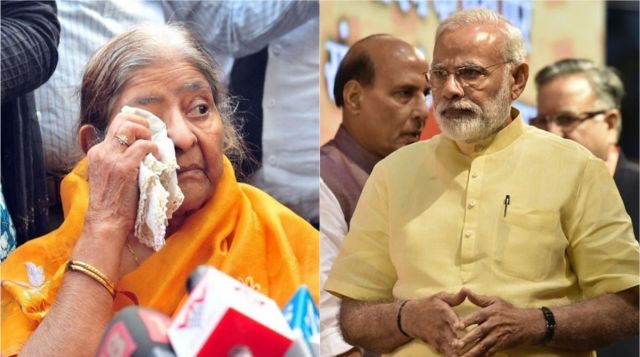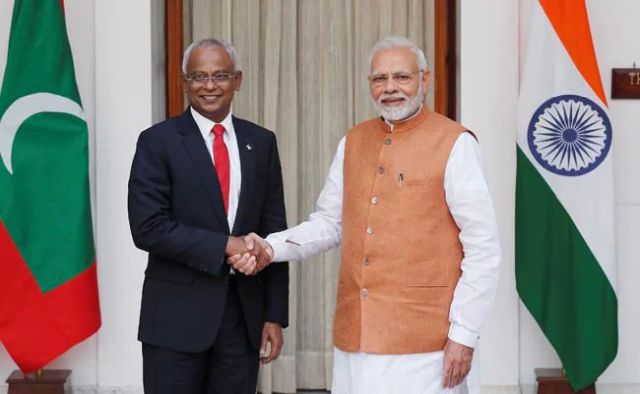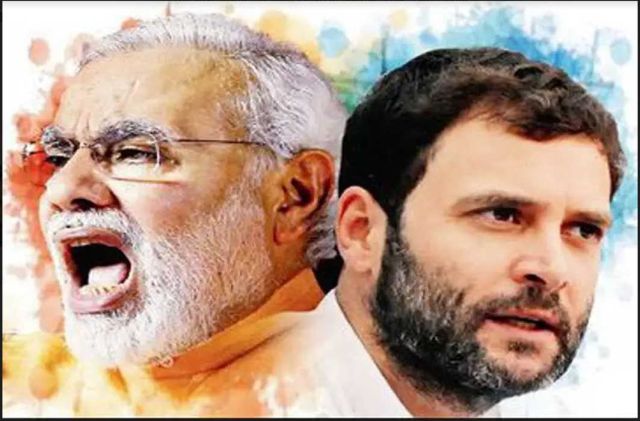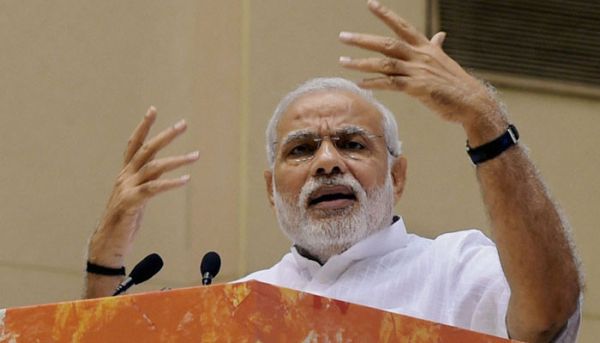
by Editor | May 25, 2021 | News, Politics
 New Delhi : Stating that conviction of party leader Sajjan Kumar in an 1984 anti-Sikh riots case should not be politicised, the Congress on Monday raked up the 2002 Gujarat riots demanding punishment for BJP leaders alleged to be involved in the communal violence that claimed over 1,000 lives.
New Delhi : Stating that conviction of party leader Sajjan Kumar in an 1984 anti-Sikh riots case should not be politicised, the Congress on Monday raked up the 2002 Gujarat riots demanding punishment for BJP leaders alleged to be involved in the communal violence that claimed over 1,000 lives.
On a day when the Delhi High Court convicted and sentenced Kumar to life imprisonment, Congress leader and former Union Minister Kapil Sibal pointed finger at Prime Minister Narendra Modi who was at the helm of Gujarat during the 2002 riots.
“Kumar doesn’t hold any office nor was given ticket by the party to contest polls, whereas the Bharatiya Janata Party (BJP) leaders, who were involved in the riots, have been given positions of power. The one who was the Chief Minister then has become the Prime Minister now,” Sibal told the media here.
While Modi, the then Gujarat Chief Minister, was given a clean chit by the special investigation team (SIT) in connection with the 2002 Godhra riots, it has been challenged before the Supreme Court which has adjourned the matter till January.
The clean chit to Modi has been challenged by Zakia Jafri — widow of Congress leader and former member of Parliament Ahsan Jafri — who was killed in the Gulbarg Society massacre, one of the worst incidents during the riots.
Reacting to Kumar’s conviction, Congress leader Abhishek Manu Singhvi also said that the matter should not be politicised.
“His conviction is not a political issue, the cases have been on for over 20 years and there have been several convictions and acquittals. This should not be seen in a political context and people should not try to seek political mileage from it,” Singhvi told the media here.
Kumar was sentenced to imprisonment for the remainder of his natural life, with the Delhi high Court holding that the violence was a “crime against humanity” engineered by politicians with assistance from police.
—IANS

by Editor | May 25, 2021 | Corporate, Corporate Governance, News
 New Delhi : India and the Maldives on Monday agreed to deepen cooperation to maintain peace and security in the Indian Ocean region as New Delhi extended lines of credit worth $1.4 billion to the archipelago nation following delegation-level talks between Prime Minister Narendra Modi and Maldives President Ibrahim Mohamed Solih here.
New Delhi : India and the Maldives on Monday agreed to deepen cooperation to maintain peace and security in the Indian Ocean region as New Delhi extended lines of credit worth $1.4 billion to the archipelago nation following delegation-level talks between Prime Minister Narendra Modi and Maldives President Ibrahim Mohamed Solih here.
The two sides also signed four agreements, including on cultural cooperation, IT and electronics cooperation and on improving the ecosystem for agribusiness.
“President Solih and I agree that to maintain peace and security in the Indian Ocean region, we need to deepen our cooperation,” Modi said while jointly addressing the media with Solih after the talks.
“Both India and the Maldives share equal interest and stake in the development and stability of our region,” he said.
Stating that the security interests of the two countries are related to each other, Modi said that there is also unanimity on the sustainability of this region and to be conscious of each other’s interests and concerns.
“We will not allow the use of our countries to harm each other,” he said.
“I want to work together with President Solih for the bright future of our region, and utilise all possibilities in the relationship between India and Maldives.”
According to a joint statement issued following the talks, both leaders agreed to strengthen cooperation to enhance maritime security in the Indian Ocean region through coordinated patrolling and aerial surveillance, exchange of information and capacity building.
“The two leaders reaffirmed their unwavering commitment and support for increased cooperation in combating terrorism in all its forms and manifestations both within the region and elsewhere,” it stated.
“Both sides agreed to enhance bilateral cooperation on issues of common concern, including piracy, terrorism, organised crime, drugs and human trafficking.”
The Prime Minister hailed Maldives’ decision to re-join the Commonwealth and welcomed the country as the newest member of the Indian Ocean Rim Association.
In his address, Modi also said that India is proud that the Maldives has become a medium income country from being a least developed country.
“The Maldives achieved this despite facing the challenges of sustainable development and climate change,” he said.
“In resolving these challenges, and in the sustainable development of marine resources, the role of Maldives will be important throughout the world.
“Therefore, we agreed to increase mutual cooperation on the various aspects of maritime cooperation between India and the Maldives.”
The Prime Minister said that India will always with be the Solih government in its efforts to carry out ambitious plans for changing the lives of the people of Maldives, and to give a human face to development in the country.
“I am glad that as a direct expression of this commitment, for the socio-economic development of the Maldives, India will extend budget support, currency swap and concessional lines of credit worth $ 1.4 billion,” he said.
Modi also called for boosting connectivity between India and the Maldives saying that better connectivity will lead to exchange of goods and services, information, ideas, culture and people.
He assured Solih of strengthening the two nations’ partnership in health, human resource development, infrastructure, agriculture, capacity building, ICT and tourism.
In this connection, Modi offered additonal 1,000 seats in India for Maldivian nationals for training and capacity building.
The Prime Minister also called for boosting commercial relations and bilateral trade.
“I welcome the growing opportunities for investment by Indian companies in the Maldives,” he said.
According to the joint statement, both leaders agreed to promote closer economic cooperation in sectors such as fisheries development, tourism, transportation, connectivity, health, education, information technology, new and renewable energy and communications.
On his part, Solih said that during the discussions, both sides reaffirmed their commitment to democracy.
“We agreed on the mutual need for regional stability and security in the Indian Ocean,” he said.
According to the statement, Solih reaffirmed his government’s India-First Policy, and commitment to working together closely with India.
“He appreciated the generous assistance provided by the government of India to Maldives, and identified various areas for developmental cooperation, including private sector involvement in development of housing and infrastructure, water and sewerage systems in the outlying islands, healthcare, education and tourism,” it stated.
In his address, Solih said that he has invited both President Ram Nath Kovind and Modi to visit the Maldives next year
Earlier in the day, Solih was accorded a ceremonial welcome at the Rashtrapati Bhavan during which Modi greeted him with a hug.
External Affairs Minister Suhma Swaraj also called on the visiting dignitary and discussed all aspects of the bilateral ties.
Solih arrived here on Sunday on a three-day visit to India, his first foreign visit since assuming office on November 17.
Relations between India and the Maldives deteriorated after Solih’s predecessor Abdulla Yameen imposed an internal emergency in February this year. Yameen was also seen as leaning towards China sidelining India.
Solih defeated Yameen in the elections in September to take over as President.
—IANS

by Editor | May 25, 2021 | Books
 By Arun Kumar,
By Arun Kumar,
Book: Open Embrace: India-US ties in the Age of Modi and Trump; Author: Varghese K. George; Publisher: Penguin Random House India; Price: Rs 599.
Donald Trump’s “America First” politics with its anti-Islamism focus and Narendra Modi’s nationalist agenda forged by the so-called “Hindutva Strategic Doctrine” make the two so dissimilar world leaders “natural allies”.
That’s the premise on which Varghese George, US correspondent for The Hindu, has tailored his book to suggest that the Modi-Trump brand of politics would likely continue to shape India and America and their relations long after they have gone.
Like a lawyer’s brief, he has marshaled arguments with painstaking research to back his theory. But in the absence of counter-arguments, it often seems a stretch.
For instance, Trump, he suggests, has sought to make a critical change to the racial politics of America, somewhat like what Modi has done to caste politics in India. And both are also clear about a “global civilizational alliance”.
While previous Indian Prime Ministers, including the Bharatiya Janata Party’s (BJP) Atal Bihari Vajpayee, sought to package changes in Indian foreign policy directions as improvements, both Modi and Trump keep projecting themselves as changers even when nothing changes.
But unlike Trump, who has spawned “resistance” at home, this prospect of change seen in Modi’s speech to Congress about US and India overcoming “hesitations of history” has united lovers and haters of Obama and Trump in fractious Washington in admiring Modi.
If the Modi-Obama hugs fostered a joint strategic vision to challenge China in the Indo-Pacific and the Indian Ocean region, his bonhomie with Trump was seen in America as an “open embrace” for resisting “China and setting the global agenda”, says George.
But unlike “greenhorn” Trump, who has no ideological moorings, Modi’s world view must be influenced by what George calls a Hindutva Strategic Doctrine.
This doctrine, according to George, imagines India to be a natural homeland of all Hindus with refugees from other religions seen as “infiltrators”. Trump too has sought to make a similar distinction between Christian and Muslim refugees seeking asylum in the US.
While US-India relations have been on an upward trajectory since the lifting of post-nuclear test sanctions, George suggests Trump and Modi are likely to build a relationship that will bring India and America too close for comfort.
The author also makes a vary valid point that the charge of a Russian hand in getting Trump elected has not only undermined his authority, but an anti-Russian hysteria, fueled by the mainstream media, has also gripped the American traditional strategic community.
Trump and the American establishment undermine each other on relations with Russia and Iran, cumulatively weakening America’s position in Afghanistan as well, he suggests. This has also affected India-US relations.
Interestingly, George recalls how after touring across the US, he and another Indian journalist chose to go to the Trump election headquarters on election day when pollsters, pundits and the press were predicting a Hillary Clinton win.
Apparently, sometimes it takes an outsider to see clearly.
(Arun Kumar was till recently the Washington correspondent of IANS. He can be contacted at arun.kumar558n@gmail.com)
—IANS

by Editor | May 25, 2021 | Opinions, Politics
 By Amulya Ganguli,
By Amulya Ganguli,
By setting in motion the process of undoing the pronounced pro-Bharatiya Janata Party (BJP) tilt in Indian politics when the party secured a majority in the Lok Sabha and ruled at one time over 19 states, the voters of the three heartland states of Rajasthan, Madhya Pradesh and Chhattisgarh have sent out two unambiguous messages.
One is the old warning about pride preceding a fall. The hyperbole of the BJP president Amit Shah’s declaration that his party will rule for 50 years has been shown to be so much hot air as has been the observation of a loyal mandarin, national security adviser Ajit Doval, that the country needs a strong, stable government – obviously meaning Narendra Modi’s rule – for the next 10 years.
It was in keeping with these grandiose assertions that the BJP built the world’s tallest statue – of Congress stalwart Vallabhbhai Patel, whom the BJP can be said to have misappropriated from the Congress – and announced the plans for an almost equally large statue of Lord Ram.
But none of these achievements and claims have saved it from a 0-3 drubbing at the hustings. The lesson from this electoral whitewash of the three BJP-ruled states is that no mercy can be expected from the electorate for the Modi government’s failure to keep the promise of vikas or development. It is obvious that economic stagnation and agricultural distress have spelt doom for the BJP.
The second message from the results is that Rahul Gandhi has succeeded in exposing the falsity of the charges that had been levelled against him ever since he came into politics. Yet, neither being derisively called “Pappu” or an adolescent kid, or of being a “pathological liar”, to quote Arun Jaitley, had any effect on his emergence as a capable leader, who took the lead in addressing the media after the recent opposition conclave while veterans like Sharad Pawar and H.D. Deve Gowda remained in the background.
It is now obvious after the Congress’s success in Rajasthan, Madhya Pradesh and Chhattisgarh that Rahul Gandhi will increasingly be in the forefront of the mahagathbandhan (grand alliance) efforts, especially when the other major convener of the alliance, Chandrababu Naidu, has suffered a setback because of his Telugu Desam Party’s poor showing in the Telangana elections.
The taking of centre-stage by the Congress president is likely to turn the 2019 general election into a presidential-style contest between him and Narendra Modi. Up until last Tuesday, the BJP would have looked forward to such an unequal fight, in its view, between Pappu and the party’s hero with his macho image.
But no longer. Now, it will be a confrontation between the youthful standard-bearer of a rejuvenated party and the aging leader of an organisation which is seen to be on a slippery slope because of failures on several fronts – economic, administrative as the disarray in the Central Bureau of Investigation and the Reserve Bank of India shows, and an “inability” – whether inadvertently or by design – to rein in the Hindutva storm-troopers.
It is possible that these Hindu militants were let loose with one of the BJP’s chief propagandists, UP Chief Minister Yogi Adityanah, instigating them with his venomous Ali-Bajrang Bali communal polasization because the party had been sensing for quite some time – presumably after its setbacks in Karnataka – that it was losing ground.
Seeing the receding mirage of the Hindu rashtra, which was thought by the saffron brotherhood to be within reach because of the BJP’s political clout, the Rashtriya Swayamsevak Sangh (RSS), purportedly a “cultural” organization, jumped into the fray with its demand for the immediate enactment of a law for constructing the Ram temple.
Its calculation apparently was that the law would shore up the BJP’s sagging political fortunes by mobilising the Hindus behind the party. If BJP MP Subramanian Swamy is to be believed, it is the drive for Hindutva which enthuses the saffron cadres and brings in votes for the party, and not vikas.
But the ploy, which included a pledge by the RSS to revive the Ramjanmabhoomi movement of 1992-93 which led to the Babri masjid’s demolition, failed to check the Congress’s revival and the signs of erosion of the BJP’s base of support.
Now that a presidential-style contest is on the cards, it will be advisable for Rahul Gandhi to live up to the lesson which he says he has learnt from Modi’s mistake – that of a lack of humility because “arrogance is fatal for a politician”.
While the Prime Minister has tweeted his acceptance of the people’s “mandate”, some of the spokespersons of the BJP and the RSS have been describing the Congress’s success in Rajasthan and Madhya Pradesh as “accidental” because of the marginal difference in the vote share of the two parties.
In Rajasthan, the Congress received 39.3 per cent of the votes while the BJP got 38.8. In Madhya Pradesh, the BJP’s percentage was higher at 41 compared to the Congress’s 40.9 per cent although the Congress won a larger number of seats.
The BJP is evidently unwilling to accept a result which has upended its dream of ushering in a Congress-mukt (free) India.
(Amulya Ganguli is a political analyst. The views expressed are personal. He can be reached at amulyaganguli@gmail.com)
—IANS

by Editor | May 25, 2021 | Opinions
 By Frank F Islam,
By Frank F Islam,
In this year’s Ease of Doing Business report, India moved up 23 positions to reach 77th — the highest the country has ever been placed in the 15-year history of the survey. India must continue its journey on that path until it ranks at or near the top of the ranked countries
“We want to make India a destination which not only welcomes business but where it is easy to do business.” Prime Minister Narendra Modi made this promise at the US India Business Council meeting on June 7, 2016. Now, just a little more than two years later, India is on the right path to deliver on that promise.
That’s what the flagship Ease of Doing Business Report (Report or World Bank Report) released by the World Bank shows. In this year’s report, India moved up 23 positions to reach 77th — the highest the country has ever been placed in the 15-year history of the survey.
The Ease of Doing Business survey studies regulations that affect businesses in over 190 economies around the globe. Its ranking is based on indices such as the required procedures and time to start a business; registering property; protection of investors; and enforcement of contracts.
The new report highlighted the fact that India is one of the 10 countries “with the most notable improvement in Doing Business” this year. In fact, India was one of the only two countries that figured in the list of top 10 improvers for two consecutive years. The other is Djibouti.
This is evidence that the flurry of reforms made by the Indian government to improve business conditions, after Modi’s promise to the global business leaders in the US Capitol, have paid off. As the World Bank Report notes, India has made 14 “sizeable improvements” in the past two years.
Most notable among them was the replacement of the value added tax (VAT) with the Goods and Services Tax (GST). The GST got off to a rough start because of considerable initial confusion regarding it and multiple changes during its first year of existence. It is established now and — it will, no doubt, make life a lot easier for businesses. As the World Bank Report pointed out, the GST, a single-tax system, is a vast improvement on the multilayered VAT framework, making the payment of tax a lot easier.
Other regulatory measures initiated by India in the past year that have resulted in the higher ranking identified in the report include the integration of multiple application forms into a general incorporation form; the streamlining of construction permits; the lowering of electricity charges; and increased access to credit.
Another example of substantial improvement is provided by the area of business registration. In 2003, the process was a long-term project requiring roughly three months. Currently, the process takes less than two-and-a-half weeks. Today, there is also much greater access to capital in India than ever before.
Each and all these improvements are critical to India’s future economic growth. An economy as large as India’s will always pique the interest of the outside world because of its sheer size and the number of consumers it boasts. That’s why since the early 1990s when doing business was not as easy multinational companies have pursued selected business development opportunities in India.
But, now with the country’s nominal GDP fast approaching the $3-trillion mark, an uninterrupted and increased inflow of foreign investment and sustained domestic investment are essential for the continued growth of the economy. There is a definite need to diversify and magnify the nature and levels of investment.
The good news, as the foregoing attests, is that the Modi administration has made excellent strides in improving the investment climate and the ease of doing business. This has given both domestic and international businesses the confidence to increase and expand their business initiatives in India.
In spite of this real and significant progress, much work still needs to be done for India to unleash the full potential of its economy and to become a world leader in terms of the ease of doing business.
The permit raj may have weakened, but it is still there. As an example, in the report’s specific index for starting a business, India ranks behind 136 countries. In India, it takes more than six months on an average to obtain a construction permit and registering a property takes more than a month and a half. These signal that there is quite a way to go on this path.
But India is on the right path. Just two years ago, India was ranked 130th. Today, it ranks 77th.
India must not consider 77th as good enough. It must continue its journey on that path until it ranks at or near the top of the ranked countries. Reaching that destination will ensure a solid future for India and its citizens.
Frank F Islam is an entrepreneur, civic leader, and thought leader based in Washington DC.
The views expressed here are personal

 New Delhi : Stating that conviction of party leader Sajjan Kumar in an 1984 anti-Sikh riots case should not be politicised, the Congress on Monday raked up the 2002 Gujarat riots demanding punishment for BJP leaders alleged to be involved in the communal violence that claimed over 1,000 lives.
New Delhi : Stating that conviction of party leader Sajjan Kumar in an 1984 anti-Sikh riots case should not be politicised, the Congress on Monday raked up the 2002 Gujarat riots demanding punishment for BJP leaders alleged to be involved in the communal violence that claimed over 1,000 lives.



